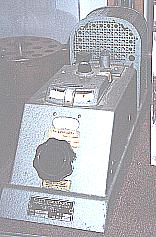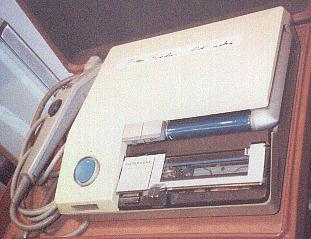Guesses Received:
Three months and no guesses! Maybe Thang #3 was a little too tough.
Not enough old microbiologists surfing the 'Net, I guess.
================== A N S W E R ==================
This is a Klett colorimeter, a device used to measure the turbidity of fluids,
usually liquid bacterial cultures. Microbiological culture broth starts out clear or translucent,
but over time it becomes harder to see through as the bacteria multiply. The colorimeter
quantifies a fluid's clarity (or lack thereof) by measuring its absorbance.
Here's How It Works
A light source housed in the back of the machine shines a beam towards the front,
where it hits a detector. The fluid is placed in the sample port between the light source and the detector,
either as a sample in a test tube or as a side arm flask (a special type of Erlenmeyer flask
with a test tube grafted onto the side). The floating bacteria deflect the beam, reducing its
intensity or "absorbing" the light. Less light reaches the detector, and the difference from
the pre-growth baseline value is expressed as Klett absorbance units.
Measurements are taken at intervals, and a fixed volume of the culture is spread onto plates of
solid culture media each time. Counts of the bacterial colonies that emerge are plotted against
the corresponding absorbance measurement. The resulting growth curve enables one to
determine the concentration of viable bacteria for any given Klett unit.
Modern colorimeters are handheld units suitable for work in the field.
I was almost afraid to say I remember using one of these benchtop machines back during my undergraduate
summer student research days. But then I found one university that is still teaching
their students how to use colorimeters in a microbiology
Growth and Metabolism lab.
[Back to TOP]
Guesses Submitted
- Could this be a platelet counter?
From: Donna Leach
Date: Sat, 14 Mar 1998 16:15:11 -0500
- This looks like a dictation machine, but it doesn't seem
'medical' enough, so I'm going to have to think about this
harder.
I see a hinge at the back, and the big blue button at the front
must be a button to release the 'cover'. On the right hand
side, it looks like there's conveyer belt, which maybe it to
put a sample of something through. The other buttons are
a mystery.
How close am I?
From: Tak Ariga, Toronto ON
Date: Wed, 18 Mar 1998 16:38:58 -0500
- Could it be an Ultrasound machine of some kind?
From: Jack Preusse, Copenhagen DK
Date: Thu, 14 May 1998 14:39:20 +0200
================== A N S W E R ==================
It's an old dictaphone! This model, used during the 1950's, recorded dictation on
an oblong belt of magnetic blue plastic tape, hence the brand name "DictaBelt".
The advertising slogan for this device was, "Secretary can't take shorthand? Give her a 'Belt!".
The belt unit is removed for transcription by sliding it out the right-hand side.
The pointer on the front shows how much room (dictating time) is left on the belt,
and the blue dial controls the recording volume.
That's the microphone on the left, with its curled-up cord.
Perhaps the best thing about this piece is the sumptuous (Corinthian?) leather case it comes in!
Modern dictaphones use 2x1-inch microcassettes and can be as small as 5x2-inch self-contained handheld units.
More recently, rapidly improving computer voice recognition software is threatening to make
dictaphones -- and dictatypists -- obsolete.
Along with a pathologist's microscope, his/her dictaphone is a piece of equipment that
he/she uses every working day. Dictations (or more specifically the resulting pathology reports)
are the main and in some cases only means by which most pathologists interact with their clinical colleagues and patients.
This is part of a larger low-profile image problem that pathologists have, which hinders --
some say even threatens -- the profession in this time of shrinking hospital budgets
(it's easy to overburden or downsize someone you never see or don't know about),
but that is beyond the scope of this blurb. Suffice it to say that as things stand,
dictaphones are very important to the practice of pathology.
Dictaphones are not specific to pathology or medicine, but they have a significant role in health care.
What data should be included in the patient record? Does the fact that doctors have to dictate
their findings result in information loss? How are medical data stored and subsequently disseminated?
These are some of the central issues dealt with by the emerging field of
medical informatics.
Related Links
Dictaphone History
Dictation Machines: From Wax to Wire, Belt to Digital
It's the Machine Dictators Love
Home of Dead Recording Media
David Morton's morgue of a different kind
 Unknown Thang #3 (November 97-January 98)
Unknown Thang #3 (November 97-January 98)
